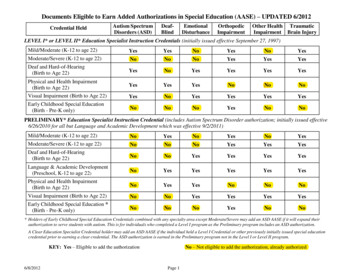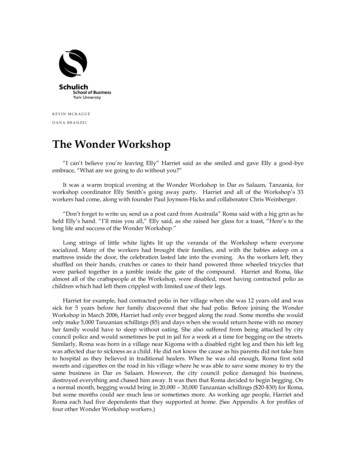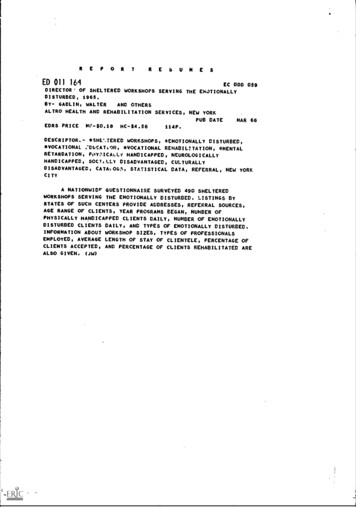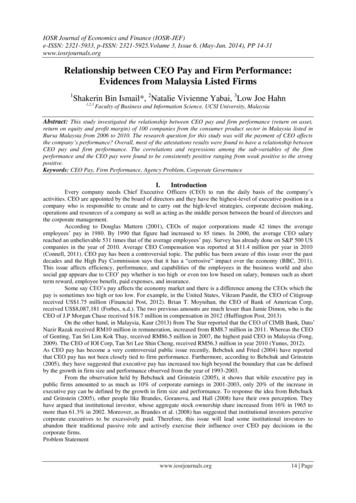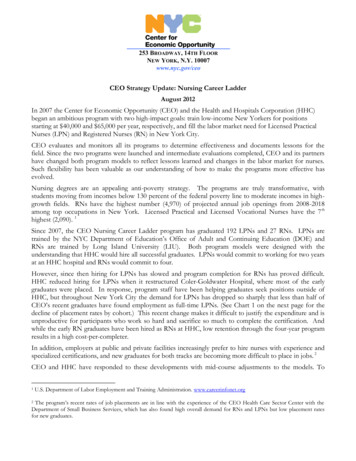
Transcription
Forthcoming, Journal of Corporate Finance, 2004.Are Outsiders Handicapped in CEO Successions?Anup AgrawalUniversity of AlabamaCulverhouse College of BusinessTuscaloosa, AL 35487-0224(205) ersonnel/AnupAgrawal.htmlCharles R. KnoeberN.C. State UniversityCollege of ManagementRaleigh, N.C. 27695-8110(919) 513-2874charles knoeber@ncsu.eduTheofanis TsoulouhasN.C. State UniversityCollege of ManagementRaleigh, N.C. 27695-8110(919) 513-2661fanis tsoulouhas@ncsu.eduCurrent draft: April 2004We thank George Baker, Jim Booth, Jeff Coles, John Conlan, Rick Geddes, Stu Gillan,Vidhan Goyal, Mark Helmantel, Mike Hertzel, Jayant Kale, Jon Karpoff, Omesh Kini,Mike Lemmon, Uri Lowenstein, Ron Masulis, David Nachman, Tom Noe, Mike Rebello,Harris Schlesinger, Rick Smith, Bob Tollison, participants in the Atlanta FinanceWorkshop, the 2000 Accounting and Finance Conference in Tel Aviv, 2001 Associationof Financial Economists meetings, and seminars at Alabama, Arizona State, CIRANO(Canada), Claremont McKenna, Clemson, Kansas, Louisiana State, Mississippi, Utah andVanderbilt for useful comments. Special thanks are due to Jeff Netter (the editor), JeffJaffe, Randy Kroszner, Bob Parrino and an anonymous referee for helpful suggestions,and to Bob Parrino for generously sharing some of his data. Chris Cain, Sahiba Chadha,Bin Huangfu and Samir Kamat provided excellent research assistance. Agrawalacknowledges financial support from the William A. Powell, Jr. Chair in Finance andBanking. Earlier drafts of this paper were entitled, “CEO Succession: Insiders versusOutsiders”.
2Are Outsiders Handicapped in CEO Successions?AbstractWe argue that outsiders are handicapped in CEO successions to strengthen theincentive that the contest to become CEO provides inside candidates. Handicappingimplies that a firm is more likely to pick an insider for the CEO position where insidersare more comparable to each other and less comparable to outsiders, and where there aremore inside candidates. Using a novel measure of the comparability of insiders based onfirm organizational structure, we analyze over 1,000 CEO successions in large U.S. firmsover the 1974-1995 period and find a variety of evidence consistent with theseimplications of handicapping.JEL Classification: G34Keywords: CEO succession, Corporate governance, Promotion incentives, Executivecompensation, Tournament theory.
3Are Outsiders Handicapped in CEO Successions?1. IntroductionWhen picking a new Chief Executive Officer (CEO) a firm can appoint an insidesuccessor, promoting a lower ranked executive to the top position, or it can appoint anoutsider, hiring someone new to the firm. Most often, firms choose to promote insiders.For large U.S. firms over the period 1974-1995, better than 80 percent (848 out of 1,035)of all CEO successions involved the promotion of an insider to the CEO position.Clearly, insiders are more likely to be picked as CEO. Why?One likely possibility is that insiders are typically more able than outsiders. Thiswould not be the case if the same managerial skills were useful everywhere; that is, if allmanagerial human capital were general. But it could be the case if an important part ofany manager’s human capital were firm specific. Here, insiders, who have acquiredknowledge and relationships by working within the firm, typically would be more ablethan outsiders who lack these assets. Similarly, because of prior interaction, Boards ofDirectors may have more confidence in their assessment of the ability of insiders. Forboth reasons, firms picking the most able candidate to become CEO would tend to pickinsiders. This surely happens.Another possibility is that, even when insiders are not typically more able thanoutsiders, they are favored anyway. That is, firms may handicap outsiders, requiring anoutsider to be markedly better than insiders in order to be chosen as CEO. But whywould outsiders be handicapped? Following the literature on tournaments (Lazear andRosen, 1981; Rosen, 1986; Chan, 1996), the answer is “to provide an incentive forinsiders to work hard.” The selection of a CEO pits executives aspiring to the topposition against each other in a contest (tournament).1,2 Because becoming CEO is1Interestingly, Gibbons and Murphy (1990) provide evidence that the likelihood of CEO turnoverdepends upon a firm’s relative performance, falling as a firm’s own performance improves andrising as other firms’ performance improves. This suggests that contests may determine not onlywho is chosen to replace a CEO, but also when a CEO is replaced.2Naveen (2000) looks at succession planning where firms appoint an insider as heir-apparent tothe current CEO. She finds that firms with an heir-apparent are more likely to replace the CEOand that being named heir-apparent increases an individual’s chances of being named the newCEO. Following Vancil (1987), succession planning can be viewed as an alternative to a contest
4desirable (the CEO job is a prize), aspiring executives will work to try to become CEO.That is, the contest to become CEO provides an incentive to work hard. And a firmbenefits from hard work by its executives. Because the strength of the incentive providedby the contest to become CEO depends upon how closely hard work and success (thelikelihood of becoming CEO) are linked, a firm gains by making this link stronger.Handicapping outsiders typically does this (Chan, 1996). So firms seeking to provideincentives to aspiring insiders will handicap outsiders and, as a consequence, tend to pickinsiders as CEO.Do firms do this?That is, are outsiders handicapped in CEOsuccessions?This is the question that we address. To do so, we consider three implications ofhandicapping. These are: a firm in which insiders are more comparable to one anotherwill handicap outsiders more and so be more likely to choose an insider as CEO; a firmwith insiders more comparable to outsiders will handicap outsiders less and so be lesslikely to choose an insider as CEO; and a firm with more insiders competing to becomeCEO will handicap outsiders more and so be more likely to choose an insider as CEO.The first of these is the most interesting and receives the greatest share of our attentionbecause it obtains only with handicapping. The latter two implications might also followfrom the importance of firm-specific human capital.A firm with insiders morecomparable to outsiders is likely less idiosyncratic, making firm-specific human capitalless important and so the choice of an insider as CEO less likely. And a firm with moreexecutives, to the extent that it is more complex, may entail more firm-specific humancapital and so be more likely to choose an insider as CEO.We test these implications using a data set with over 1,000 observations on CEOsuccessions in U.S. firms that occurred between 1974 and 1995. Employing a novelvariable describing firm organization to measure the comparability of insiders, anindicator of the homogeneity of firms within an industry to measure (inversely) thecomparability of insiders to outsiders, a measure of the number of executives within afirm, and a set of control variables that measure firm performance, firm size, boardcomposition, and the presence of founding family CEO, we attempt to explain the patternto become CEO (horse race succession); alternatively naming an heir-apparent can be viewed asthe outcome of a contest to become CEO.
5of insider and outsider successions to the CEO position.Overall, this attempt issuccessful. In nearly every instance, estimated coefficients have the predicted sign andthe results are generally both statistically and economically significant.The most interesting result surrounds our firm organization variable. We identifyfirms with a product or line of business organizational structure (as opposed to afunctional structure) and argue that this structure makes insiders more comparable. Andwe consistently find that this variable is negatively related to the selection of an outsideras CEO. To explore this result, we extend the analysis in two ways. First, we look atfirms with multiple successions and find that those firms that change to a product or lineof business organizational structure are more likely to pick an insider as CEO than similarfirms that maintain a functional structure. This ‘time-series’ evidence reinforces the mainfindings in our cross-sectional tests. Second, we consider the possibility that insiders atfirms with a product or line of business organizational structure might be more likely tosucceed to the CEO position not because outsiders are handicapped but because theseparticular insiders are more able. Here, we conduct two tests. One controls for theamount of overall business experience among top executives in a sub-sample of oursuccessions and finds that, even with this control, firms with a product or line of businessorganizational structure are more likely to select an insider as CEO. The other testexamines the history of outsiders who are named CEOs. If insiders at product or line ofbusiness firms are more able, they should be more likely to succeed to the CEO positionin their own firms and also more likely to be selected CEO at other firms. We find noevidence that this is the case. These latter tests offer reassurance that our finding thatfirms with a product or line of business organizational structure are more likely to nameinsiders as CEO really is evidence of outsider handicapping.The following second section of the paper describes handicapping more fully anddevelops its three empirical implications. Section 3 describes our data set, details theconstruction of variables, and outlines our empirical approach. Section 4 presents ourmain results. Section 5 provides a closer look at the effect of our most novel variable,organizational structure, on CEO succession. The final section offers a summary and aconclusion.
62. Implications of HandicappingWhenever a firm’s executives prize being named CEO, insiders will compete to winthe CEO position. Perhaps the most noteworthy recent example was the extended contestbetween division heads Jeffrey Immelt (GE Medical Systems), Jim McNerney (GEAircraft Engines) and Robert Nardelli (GE Power Systems) to succeed the legendary JackWelch as CEO of General Electric.3 But this three-way contest to become CEO is bestviewed as just the final stage in a career of contests in which these executives bestedmany others as they climbed GE’s corporate ladder. That is, many executives beyondthese three likely aspired to be GE’s CEO during their careers.Such CEO aspirations provide insiders with an incentive to work hard. The strengthof this incentive depends upon the expected reward for exerting greater effort (increasingµ). Defining W as the dollar value of incremental rewards (including non-pecuniaryrewards such as power and prestige) that derive from being named CEO (the prize), theexpected reward to an executive for exerting greater effort is the induced change in hisprobability of winning the competition to become CEO, p, times the prize or ( p/ µ)W.The larger the prize and the more responsive is an insider’s chance of winning to hiseffort, the greater is the incentive effect that CEO aspirations have on insiders’ effort.Adding outsiders to the competition to become CEO typically reduces p/ µ, i.e.,weakens the relation between hard work by an insider and his chance of succeeding to theCEO position. As a consequence, including outsiders in the succession contest typicallydulls the incentive that insiders have to work hard.4 To reestablish insider incentives, thefirm can make the CEO position more desirable by increasing the prize, W, or it canhandicap outsiders (choose the best insider unless an outsider performs markedly better)which raises p/ µ. We assume that it is difficult for the firm to raise the prize since thiscreates incentives for stockholders to renege and invites sabotage (discourages teamwork)among managers (Lazear, 1989) and concentrate instead on handicapping as the means torestore insider incentives.3Mr. Immelt was named as successor to Mr. Welch in December 2000.If insiders are not evenly matched, this may not be true. Where one insider is acknowledged tobe clearly better than others, adding outsiders to the competition to become CEO could enhancethis insider’s incentive to exert effort (the incentive of other insiders, though, would be reduced).4
7While handicapping improves insiders’ incentives to work hard, it sometimes resultsin an insider being named CEO despite the existence of a superior outside candidate (theoutsider, though performing better, doesn’t beat the handicap). As a result, there is atension (trade-off) between providing better incentives and picking a better CEO. Thistension is key and is the source of the predictions that we develop and test empirically.5Our focus is on the size of the handicap imposed on outsiders and so ultimately on thelikelihood that an insider succeeds to the CEO position.Consider the performance, q, of a candidate for the CEO position to be composed of adeterministic component, µ, that depends positively on his ability and effort and arandom component, ε, with zero mean. That is, q µ ε. We assume that the firm usesa contest to pick the new CEO where the winner is the candidate with the highest q.Picking the new CEO based on q does two things. First, it provides an incentive forcandidates to work hard since greater effort increases µ and so the expected value of qand the probability of winning ( p/ µ 0).Second, it tends to pick the most ablecandidate (the one with the highest µ) as CEO.Part of the random component in performance will be common to all candidates, andpart will be idiosyncratic to a particular candidate. Let c represent the common part and ithe idiosyncratic part, ε c i. For any ε realized by one candidate, the division betweenc and i depends on the make-up of the group of other candidates. The more similar arethe circumstances faced by all candidates, the greater will be the common portion and thesmaller will be the idiosyncratic portion. We characterize candidates as more comparablewhen (holding ε constant) c is larger.6Since a relative measure of performancedifferences out c, greater comparability implies that a contest that rewards based uponrelative performance (the winner gets to be the CEO) more closely ties the probability ofreceiving the reward to effort ( p/ µ is greater) and more reliably selects the best CEO.5Tsoulouhas, Knoeber and Agrawal (2003) presents a formal model in which insiders areassumed to be alike, incentives to work hard arise only from aspirations to be CEO, and the gainfrom picking a more able CEO is explicit. These predictions, and others, derive (at least undersome conditions) from that model.6A more formal characterization using first-order stochastic dominance is developed inTsoulouhas, Knoeber and Agrawal (2003).
8The reason in both instances is that relative q is a more precise (less noisy) measure ofrelative µ.Consider a firm that limits its CEO succession contest to inside candidates (i.e., picksthe insider with the largest q as the CEO). Here, c measures the comparability ofinsiders.Greater c means that the succession contest will have a more importantincentive effect. The reasons are two. First, as already noted, greater comparabilitymeans that the succession contest more precisely rewards effort and so provides astronger incentive to work hard. Second, since the succession contest is a more effectivemechanism to provide incentives, it will likely be relied upon more. That is, it willoccupy a more important role and other mechanisms for providing incentives, such asperformance pay, stock options, and offer-matching (relying on the managerial labormarket) will be used less.7Introducing outsiders to the succession contest (selecting as new CEO the candidate,insider or outsider, with the largest q) entails a cost. This cost stems from the fact thatoutsiders typically have less in common with insiders than do other insiders (insiders andoutsiders together are less comparable than insiders alone). Introducing outsiders, then,reduces c (and increases i), which in turn reduces p/ µ and so weakens insiders’incentives. The more comparable are insiders (the greater is c for insiders alone), themore c falls when outsiders are added and so the greater is the cost of introducingoutsiders to the succession contest. The more comparable are insiders, then, the morereason to insulate insiders from competition with outsiders (to keep the contest closed tooutsiders).Since handicapping outsiders offers partial insulation from outsidecompetition, our first prediction is that where insiders are more comparable, outsidersshould be handicapped more and so the likelihood of insider succession should begreater.The extent to which introducing outsiders reduces c and so weakens insiders’incentives depends not just on how comparable insiders are to each other (what c wouldbe if outsiders were excluded) but also on how comparable outsiders are to insiders (whatc is when outsides are included). The more outsiders have in common with insiders (the7This presumes that other mechanisms used to provide incentives are not affected (or affectedless) by greater comparability of insiders.
9more comparable are insiders and outsiders together), the smaller the reduction in c andso the smaller the decline in insiders’ incentives when outsiders are introduced into thesuccession contest. So, the more comparable are insiders and outsiders together, the lessreason to handicap outsiders. Our second prediction, then, is that where insiders andoutsiders are more comparable, outsiders will be handicapped less and so insidersuccession will be less likely.Our third prediction concerns the number of candidates (insiders and outsiders)competing for the CEO position. As there are more contestants of any kind, it is likelythat the link between an insider’s effort and his chance of becoming CEO becomesweaker ( p/ µ falls) and so incentives to work become weaker.8 Outsiders should behandicapped more to restore these incentives. The effect that this has on the likelihood ofselecting an insider as CEO depends upon whether the added contestants are insiders oroutsiders. The reason is that, holding the outsider handicap constant, the larger is thenumber of insiders the more chances insiders (as a group) have to win and so the greateris the likelihood that some one of these insiders will indeed win. Similarly, the greater isthe number of outsiders, the greater is the likelihood that some one of these outsiders willwin.So, increasing the number of contestants has two effects on the likelihood that aninsider will be selected CEO. The first effect is that firms will optimally impose a biggerhandicap on outsiders making it more likely that an insider will be selected. If the addedcontestants are insiders, the second effect works in the same direction. Since there arenow more insiders competing, the likelihood that some one of them wins will rise. If theadded contestants are outsiders, the second effect opposes the first. Here, the presence ofmore outsiders reduces the likelihood that an insider will win. Our third prediction, then,is that as the number of insiders competing to be CEO rises, the likelihood that an insiderwill succeed to the CEO position rises. Since the two effects from adding outsidecontestants oppose one another, we cannot predict the effect of adding outsiders on thelikelihood that an insider is selected CEO.
103. Data and Empirical ApproachWe begin with a sample of 1,035 CEO successions in Forbes 800 firms that occurredbetween 1974 and 1995.9 To be included in the sample the succession announcementmust be reported by the Wall Street Journal, and information about the firm’s financialperformance and about the outgoing and incoming CEOs must be available.10 FollowingParrino (1997), we classify a succeeding CEO as an insider if (s)he had been employedby the firm for more than one year prior to succeeding to the CEO position. All othersare classified as outsiders.11 We then construct a binary variable, OUTSIDER, thatequals 1 for outsiders and 0 for insiders. As shown in Table 1, 187 of the 1,035successions (18 percent) involved outsiders.Of the 187 outsiders, 111 (59.4 percent)were hired from other firms within the same primary 2-digit Standard IndustrialClassification (SIC) industry. Among the remaining 76 (40.6 percent) who were hiredfrom firms outside the industry, though, most had some prior experience (e.g., as anoutside director, consultant, or outside attorney) within the same or within a relatedindustry (see Parrino, 1997, p.178).For each CEO succession, we identified the firm and the year of the succession. Wethen examined the listing of all top executives (vice president and up, typically 15 to 20people) in the Standard & Poors Register of Corporations of that year to determine theorganizational structure of the firm.From these listings, we identified firms withexecutives whose titles indicated that they managed one of several company products(Chevrolet, Pontiac, ) or one of several lines of business (chocolate, pasta, ). Wedefine a binary variable, PL, that equals one for firms with a product or line of businessorganizational structure; it equals zero for all other firms (organized along other, such asfunctional – operations, marketing, finance – lines). As shown in Table 1, about 35percent of our sample of CEO successions occurred in firms with a product or line of8See Chan (1996, p.565-567).The sample was kindly provided to us by Robert Parrino. It incorporates most of the sample inParrino (1997), dropping only successions occurring before 1974, and adds successionsoccurring between 1990 and 1995.10For a more complete characterization of the criteria for inclusion in the sample see Parrino(1997, p.171).11An alternative specification that identifies succeeding CEOs as insiders if they had beenemployed by their firms for more than three years prior to succeeding to the CEO position yieldsessentially the same results as this specification.9
11business organization. These firms tend to be somewhat larger than others with mediansales of 2.5 billion compared to 1.7 billion for other firms and with medianemployment of 25 thousand compared to 12 thousand for other firms (not shown in thetable). Table 2 provides additional detail. Here, successions are sorted by industry andmean values of PL are presented. Except where the number of successions is small, mostindustries include both some firms with a product or line of business organizationalstructure and some firms with other structures. But firms in manufacturing are mostlikely to have a PL structure while retail and service firms are least likely to do so.Below, when we characterize industries by the homogeneity of their member firms, wealso find that firms with a PL organizational structure tend to be in industries that are lesshomogeneous.We argue that a PL organizational structure makes inside candidates for the CEOposition more comparable to one another. The vice president for Chevrolet products andthe vice president for Pontiac products face more similar circumstances (share morecommon shocks to performance) than do a vice president for finance and a vice presidentfor marketing. Our first prediction in section 2 is that greater comparability of insidersincreases the likelihood that an insider will be selected CEO. The empirical counterpartis that firms with a PL organizational structure are more likely to select an insider tosucceed to the CEO position.Two related arguments provide additional support for this prediction.12 First, thedecentralization resulting from a PL organizational structure reduces the opportunity forsabotage among competing insiders. This lowers the cost of relying on the contest tobecome CEO as an incentive device and provides a reason to strengthen this incentive.Second, decentralization also implies that important decisions will be delegated todivisions, making the role of the CEO less critical. This lowers the cost of appointing asomewhat inferior CEO and tilts the trade-off between incentives for insiders and a moreable CEO toward better incentives for insiders. Both arguments imply that successionincentives will be more important in firms with a PL organizational structure and, as a12We thank George Baker for suggesting the first argument and Tom Noe for suggesting thesecond.
12consequence, that these firms will impose a larger handicap on outsiders and so be lesslikely to select an outsider as CEO.For each of these reasons, firms with a PL structure should be more likely to chooseinsiders as CEO. The data in Table 1 are consistent with this prediction. Among firmsselecting internal candidates to succeed as CEOs, 38% have a PL organizationalstructure. Among firms selecting external candidates to succeed as CEOs, only 25%have a PL organizational structure. This difference has a p-value of less than .01.Since most outsiders who are appointed CEO come from other firms within the sameindustry, we adopt Parrino’s (1997) industry homogeneity index as a measure of thecomparability of insiders and outsiders. The more similar are firms in the industry, themore comparable are (the greater the common shocks faced by) insiders and outsiders.Parrino measured this similarity by first using monthly data from the Center for Researchin Security Prices (CRSP) for the years 1970 to 1988 to construct an equally weightedstock return index for each 2-digit SIC industry. The monthly return of each firm in theindustry was, then, regressed on the industry index and on an equally weighted marketindex.The partial correlation coefficients for the industry index were averaged acrossfirms in each industry. This average, HOMOGENEITY, is the index of homogeneity forthe industry.13It is obtained from Parrino (1997, Table 5).The greater isHOMOGENEITY, the more correlated are the stock returns within an industry and themore similar are the firms. For our entire sample of successions, HOMOGENEITY has amean (median) value of .312 (.325). Highly homogeneous industries include metalmining, oil and gas extraction, and air transportation. At the other extreme, fabricatedmetal products, wholesale trade (non-durable goods), and transportation equipmentmanufacturing are quite heterogeneous.We argue that where firms within an industry are more alike (HOMOGENEITY isgreater), the comparability of inside and outside contestants for the CEO position isgreater. Our second prediction in section 2 is that where such comparability is greater,the likelihood of selecting an insider as CEO should be smaller.The empiricalcounterpart is that as HOMOGENEITY increases, firms will be less likely to promoteinternal candidates to the CEO position. The data in Table 1 support this prediction.13For more details of the construction of HOMOGENEITY see Parrino (1997, pp. 187-188).
13Among firms promoting internal candidates to the CEO position, the mean value ofHOMOGENEITY is .308; but among firms selecting outsiders as the CEO, the meanvalue of HOMOGENEITY is .327. Once again, this difference has a p-value of less than.01.For each CEO succession, we calculate the approximate number of supervisoryemployees at the firm, SEMP, at the time of the succession.To do this, we firstdetermined the number of employees in the 2-digit SIC industry of the firm in the year ofsuccession.From this we subtracted the number of non-supervisory employees(production and related workers for manufacturing industries, construction workers forconstruction industries, and non-supervisory employees for service industries) toapproximate the number of supervisory employees in the industry. The source for thesedata is Employment, Hours, and Earnings, United States, 1909-94 and 1988-96,published by the U.S. Department of Labor, Bureau of Labor Statistics.We thencomputed the ratio of supervisory to total employees for the industry.Next wedetermined the number of people employed by the firm at the time of the succession (thesource for these data is COMPUSTAT) and multiplied this by the industry ratio ofsupervisory to total employees. The result is SEMP, our approximation of the number ofsupervisory employees at the firm at the time of succession. The mean (median) numberof supervisory employees is 10.4 (3.6) thousand. We treat SEMP as an index of thenumber of internal contestants for CEO.14Our third prediction in section 2 is that as the number of internal contestantsincreases, it becomes more likely that an insider will succeed to the CEO position. Theempirical counterpart is that firms with more supervisory employees should be morelikely to choose internal candidates to succeed to the CEO position. Again, the data inTable 1 are consistent with this prediction. The mean number of supervisory employeesamong firms promoting an internal candidate to be the new CEO is 11.3 thousand; that14The contest to become CEO comprises multiple rounds as executives work their way up thecorporate ladder. In the last round, the number of contestants is always small (three in the GEexample cited in section 2). However, the contest provides incentives not just to those fewexecutives being considered for the next CEO appointment, but also to those lower on the ladder.(For instance, Jack Welch is reported to have stated that he wanted to be CEO from the momentthat he joined GE, immediately out of college and twenty-one years prior to his eventual
14for firms selecting an outsider is only 6.3 thousand. This difference has a p-value of lessthan .01.For each CEO succession, we also calculate the approximate number of supervisoryemployees at other firms in the primary 2-digit SIC industry of the firm at the time of thesuccession, SEMPIND. To do this, we simply subtra
2Naveen (2000) looks at succession planning where firms appoint an insider as heir-apparent to the current CEO. She finds that firms with an heir-apparent are more likely to replace the CEO . Aircraft Engines) and Robert Nardelli (GE Power Systems) to succeed the legendary Jack Welch as CEO of General Electric.3 But this three-way contest to .

